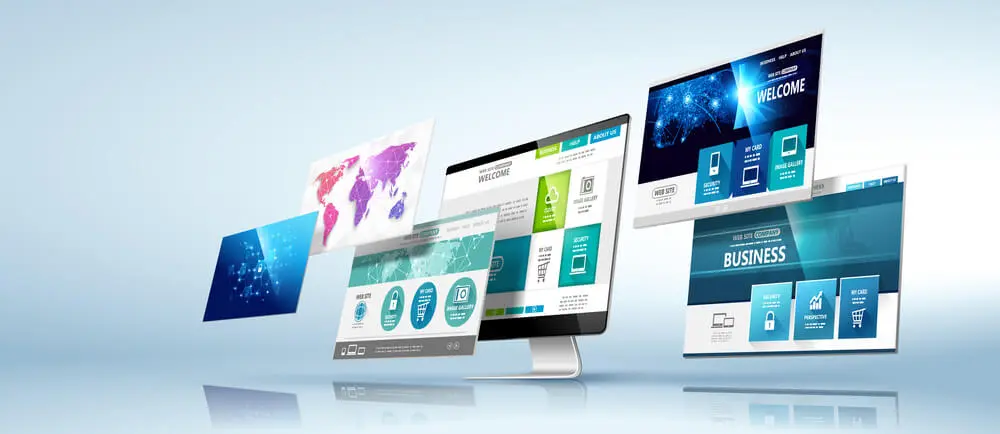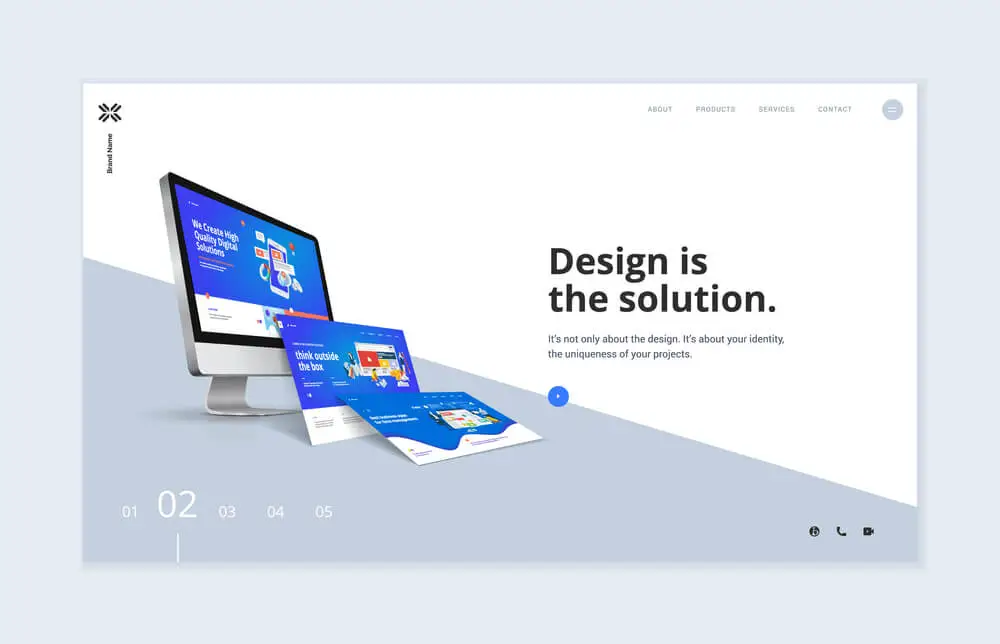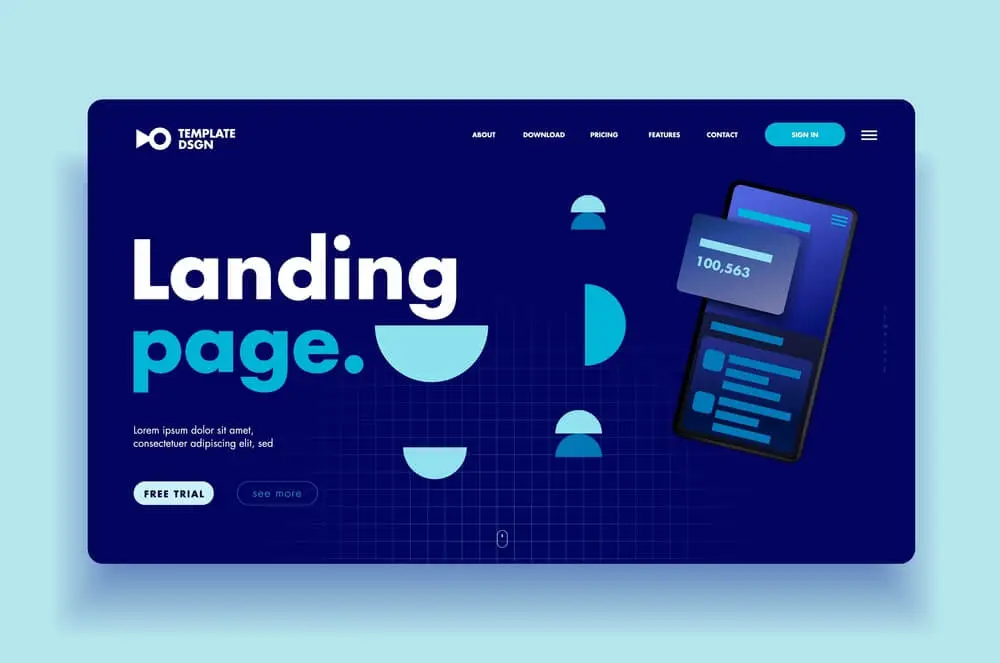E-commerce landing page design is all about focusing on one main goal—whether that’s to get leads, sell a special product, or offer a discount to new customers.
A landing page is different from any other web page. Each landing page is created with a selected motive and consists of the whole thing to assist site visitors in attaining that aim. For instance, you might want visitors to sign up for your newsletter, download your app, or buy your product.
Whether promoting your business on social media or using Google Ads, having an eye-catching landing page is key to any successful digital marketing strategy. This guide will display how effective landing pages will enhance conversion rates, accumulate leads, and appeal to potential customers.
Introduction To What Is A Landing Page?
A landing page is a standalone web page that potential customers land on when they click through advertising or marketing campaigns. These pages are regularly used by e-commerce organizations to persuade people to accomplish that. For example, a landing page ought to inspire customers to shop for a product, download an app, start an unfastened trial, or join up for a subscription service.
A good e-commerce landing page always includes:
- A compelling headline
- A strong subheading with a distinct value statement
- A visible call to action (CTA)
Depending on the goal of the campaign, an e-commerce landing page can also include:
- A powerful film or picture of a hero
- Customer endorsements and reviews serve as social evidence.
- Form fields to gather client data for lead-generating
These elements help make e-commerce websites more effective by turning visitors into customers. Focusing on the mentioned components would help your landing page increase the conversion rate and, therefore, make more sales.
Key Differences Between a Landing Page and a Homepage
While landing pages and homepages are two separate kinds of web pages that businesses utilize, they accomplish quite different things.
1- Goals
Homepages help customers interact with your brand in various ways. They communicate your company’s vision and story, providing a robust overview of your products and services. A homepage might include multiple CTAs (calls to action) to encourage visitors to take different actions. A UI/UX designer can ensure your homepage effectively engages visitors.
In contrast, landing pages are focused on driving customers toward one particular goal. The entire page leads customers to complete a specific action to achieve that goal. You may want to encourage visitors to download promotional materials, join up for a free trial, buy a product, or fill out a form on your landing page. To efficiently construct sites that turn visitors into buyers, consider using a landing page design agency.
2- Design
A homepage means that your customers can freely browse your company. visitors can get an insight into your products and services, read the feedback of other customers, view your vision statement, and make other entertainment such as blogs and videos.
Homepages are usually more complex than landing pages, with multiple sections, easy-to-find navigation bars, job postings, customer service info, and links to your social media channels. A good e-commerce website builder can help you create a well-organized and informative homepage.
On the other hand, landing page designs are simpler and focus on one main goal, like getting customers to make a purchase or sign up. They don’t have many sections or links to other pages, keeping visitors focused on that single action. A well-crafted landing page design helps drive conversions by minimizing distractions and keeping the focus on the main objective.
3- Call-to-Action Buttons
Every e-commerce landing page should have a call-to-action (CTA) button. A CTA button encourages visitors to take immediate action, like submitting a form, signing up for a subscription, or making a purchase. The button text is usually short and direct, such as “Learn More” or “Sign Up.”
For example, a clothing store might use a “Get 15% Off” CTA button next to a newsletter sign-up form that says, “Save 15% off your first order when you sign up for our newsletter today.”
Landing pages are designed to keep customers focused on one main goal. Unlike a homepage, which has various calls to action and encourages visitors to explore different parts of the site, an optimized landing page has just one CTA. As a web designer in Dubai, you should place the CTA button where it’s easily seen, usually “above the fold.” This means it’s at the top of the page where visitors can see it without having to scroll down.
Different Types of Landing Pages
1- Lead Generation Landing Pages
A lead generation landing page, also known as a lead capture page or a squeeze page, encourages prospective customers to fill out a specific form. These forms usually ask for information like email addresses, phone numbers, and demographic details.
A web designer in Dubai can help create an effective lead-generation landing page that lets you learn more about your target audience, improve your marketing campaign, build an email list, and collect lead data for future sales. Lead capture landing pages often offer something valuable in return. For example, customers might get a free ebook, marketing materials, another useful resource, or a discount code when they submit their information.
2- Click-Through Landing Pages
Click-through landing pages encourage users to complete one specific action, like making a purchase or signing up for a subscription service.
Unlike lead-generation landing pages, click-through landing pages include CTA buttons without asking for personal information. The goal is to convert visitors into customers or subscribers, rather than to gather data. This type of landing page is often used in e-commerce marketing and features compelling CTA buttons like “Buy now” or “Get started.” A click-through landing page might also include a value proposition, such as a free trial or special offer.
3- E-commerce Landing Pages
An e-commerce landing page is designed to drive sales by focusing on one main action. These pages often include eye-catching visuals, clear messaging, and strong call-to-action buttons to guide visitors toward making a purchase. E-commerce landing pages are crucial for online stores looking to boost their conversion rates and increase sales.
Key Benefits of Landing Pages
1- Lead Generation
Landing pages help you find out who your audience is and what they need. When it comes to lead generation, the landing page design strategy allows you to capture the contact information of the prospects. This makes future marketing even more precise, and you may know what customers want and how to help he or she solve the problem.
2- Brand Awareness
Landing pages can introduce your marketing materials to new customers and reinforce your brand to existing ones. If you have something new or valuable to offer, it is possible to familiarize the brand with the audience. This assists in sharing information with your customers through the landing page – whether for informative or entertainment purposes. An e-commerce website builder can help you make these pages.
3- Conversions
Targeted landing pages can boost conversion rates by leading potential customers to take specific actions. A dedicated landing page can offer more focused promotions compared to broader web pages. A Web designer in Dubai can help you create these pages to improve your e-commerce marketing results.
11 Key Tips for Optimizing Your Landing Pages
1- Simplify Your Design
When it comes to an e-commerce landing page, less is more. Keep viewers focused on a specific goal with simple design elements and clear text. Only include the necessary elements, and use bullet points to make the text easier to read.
2- Craft Engaging Copy
An e-commerce website that converts needs a catchy headline and a persuasive subheading that clearly shows the benefits. Make sure to speak in short, assertive phrases using active language. Pay special attention to the words you use for your CTA buttons. For example, avoid generic words like “Submit” or “Complete.” Instead, use active phrases like “Sign up,” “Buy now,” or “Get your discount.”
3- Add Social Proof
Social proof helps customers make decisions based on other people’s opinions and actions. A UI/UX designer can assist you in the integration of social proof in your landing pages in the form of customer reviews, testimonials, and case studies. This proves the effectiveness of your product or service in meeting the customer’s needs.
4- Optimize for Search Engines
Your landing pages may be found by potential clients with the use of search engine optimization (SEO). SEO involves the utilization of appropriate keywords when creating headlines and any other text that can be placed online. This can help take your brand’s organic search traffic and customers’ potential into consideration. A good landing page design service can help you with this.
A high-converting landing page uses keywords that relate to your target audience’s needs and your company’s unique value proposition. If you own an online furniture business, for instance, you might use keywords like “high-quality couches” to convey durability, or “multipurpose furniture” to appeal to people in small apartments.
5- Present a Clear Value Proposition
High-converting landing pages offer something valuable to your customers, like a free resource, a discount code, or relevant content. When working on your landing page design, make sure to clearly state what you are offering, highlight it on the page, and deliver on that promise.
6- Use Eye-Catching Visuals
Not everyone prefers to get information through text alone. Adding visuals like product screenshots, illustrations, photos, GIFs, or videos can help engage visual learners. This makes your landing pages more interactive and enjoyable. An e-commerce website builder can assist you in adding these elements to make your landing pages more effective. Visual content can often explain concepts more clearly and quickly than text alone.
7- Ensure Mobile-Friendliness
Since mobile users account for almost 60% of web traffic, it’s essential to design your landing page for mobile users. A Web designer in Dubai can help you create a mobile-friendly page that increases conversion rates by reaching a broader audience, not just those on desktop browsers.
8- Improve Page Load Speed
After driving traffic to your landing page, ensure it loads quickly so visitors can complete the desired action. Among the easy methods to increase landing page load speed are:
- Image compression
- Code minification
- Steer clear of carousels and sliding components
- cutting back on apps and plug-ins
You can use tools like Google’s PageSpeed Insights to see how quickly your site loads. Make adjustments as needed, then check your page speed again to see if the changes improved performance. These steps are essential for effective e-commerce marketing.
9- Focus on a Single Call to Action
The goal of an e-commerce landing page is to get visitors to take a specific action. Too many alternatives can crush human beings, making it harder for them to decide.
That’s why it’s critical to determine the principal outcomes you want from your landing page. Do you need visitors to join your publication? Purchase a product? Contact your sales team. Choose one call to action and use it consistently throughout your landing page.
10- Develop Multiple Supporting Landing Pages
Create several landing pages according to the actions you like your visitors to perform. For example, create separate landing pages for an email marketing campaign and a new product launch. This allows you to target each e-commerce website page toward a different goal, making your marketing efforts more effective.
11- Conduct A/B Testing
A/B testing is the process of comparing two landing pages with a single difference between them. The goal is to see if a specific change can affect conversion rates. A UI/UX Designer can help you identify key elements to test.
Things you could A/B test on a landing page include:
- Button colors
- Headline copy
- Social proof placement
- Page layout
- Button copy
- Hero image
- Form fields
Just remember to make only one change at a time. It might be tempting to overhaul the entire design, but doing so makes it difficult to determine which change impacted your conversion rate. A landing page design service can help you implement these changes effectively.
How to create an e-commerce landing page
1- Set Your Main Goal
When making an e-commerce landing page, first decide what you want to achieve. If you aim to increase sales for a new product, create a click-through landing page. This type of page should have a big picture of the product, explain its benefits, and include a clear button to buy it.
If you want to collect emails for a new subscription service, go for a lead generation landing page. This page should ask visitors to fill out a form with useful details for your e-commerce website.
2- Choose a Landing Page Builder
If you’re not a programmer, landing page builders are a great help. These tools let you make landing pages that blend well with your website’s homepage, sales pages, and other important sections. They’re very handy for search engine marketing campaigns.
For e-commerce brands, look for platforms that offer good templates for your products. Tools like PageFly and Shogun, found in the Shopify App Store, make it easy to customize landing pages. If you need extra help, consider hiring a UI/UX designer for your landing page design service to ensure everything looks and works great.
3- Create Your Landing Page Design
Before designing your landing page, know your goals and what you’re offering. Keep the page simple and direct, focusing on the main call to action. For effective landing page design, make your CTA buttons stand out with unique styles, fonts, and colors. Use catchy headlines and offer something valuable to your visitors, like a free ebook, a useful white paper, a special deal, or an exclusive offer.
4- Launch and Optimize Your Page
After launching your landing page, you should see more conversions from your calls to action. This could be more subscribers, customer contacts, or product sales. Use an e-commerce website builder to create and test different versions of your landing page’s design, text, and CTA buttons. A/B testing provides you with the specifics so that you can optimize for the best choice depending on the findings.
5- Develop Additional Landing Pages
Once you know how to launch a successful landing page, think about what other pages you can create to support your marketing strategy. You can start your Shopify journey by creating more landing pages for new products, email subscribers, deals, or other business objectives. The more the landing pages, the more the conversion chances for audiences about the desired action making e-commerce marketing more effective.
Conclusion:
In short, a superb e-commerce landing page is easy and has one clear purpose, like growing income or getting signal-ups. It needs a catchy headline, a clear message about what you offer, and a strong call-to-action button. Make sure it’s easy to read, looks good on mobile, and includes customer reviews and nice images. Try out special versions to see what works satisfactorily and make precise pages for different audiences. This will increase conversions and support the success of your campaign.



